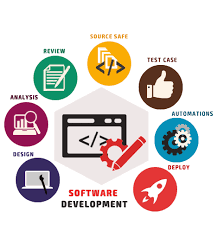Essential Software Tools for Developers: Streamline Your Workflow Today
The Essential Software Every Developer Needs
As a developer, having the right tools can make a significant difference in your productivity and efficiency. Whether you are a beginner or an experienced coder, investing in the right software can streamline your workflow and help you create better applications. Here are some essential software that every developer should consider:
Integrated Development Environment (IDE)
An IDE is a must-have tool for developers as it provides a comprehensive environment for writing, testing, and debugging code. Popular IDEs like Visual Studio Code, IntelliJ IDEA, and Eclipse offer features such as syntax highlighting, code completion, and version control integration.
Version Control System
Version control systems like Git are essential for managing code changes and collaborating with other developers. Git allows you to track changes, revert to previous versions, and work on different branches simultaneously.
Code Editor
A reliable code editor is crucial for writing clean and efficient code. Editors like Sublime Text, Atom, and Notepad++ provide customizable interfaces, support for multiple programming languages, and plugins for extending functionality.
Virtualization Software
Virtualization software such as VirtualBox or VMware allows developers to create virtual environments for testing applications on different operating systems without affecting their main system.
Database Management Tools
Developers often work with databases to store and retrieve data. Tools like MySQL Workbench, pgAdmin, or MongoDB Compass provide graphical interfaces for managing databases efficiently.
Collaboration Tools
Collaboration tools like Slack, Microsoft Teams, or Jira facilitate communication and project management among team members. These tools help developers stay organized and coordinate tasks effectively.
Conclusion
Having the right software is essential for developers to enhance their coding experience and deliver high-quality applications. By investing in these essential tools, developers can optimize their workflow, collaborate effectively with others, and stay ahead in the rapidly evolving tech industry.
Top FAQs on Developer Software: IDEs, Version Control, Collaboration Tools, and More
- What is the best Integrated Development Environment (IDE) for developers?
- How can I effectively use version control systems like Git?
- Which code editor offers the most features and customization options?
- What are the benefits of using virtualization software in development?
- How can database management tools improve my efficiency as a developer?
- Which collaboration tools are recommended for team-based development projects?
- Are there any free or open-source software options available for developers?
- What are some best practices for optimizing workflow with developer software?
What is the best Integrated Development Environment (IDE) for developers?
When it comes to choosing the best Integrated Development Environment (IDE) for developers, the answer can vary depending on individual preferences and specific project requirements. Popular IDEs like Visual Studio Code, IntelliJ IDEA, and Eclipse are often recommended for their robust features, extensive plugin support, and user-friendly interfaces. Developers may prioritize factors such as language support, debugging capabilities, version control integration, and community support when selecting an IDE that best suits their needs. Ultimately, the best IDE for developers is one that enhances productivity, streamlines the coding process, and aligns with their coding style and workflow.
How can I effectively use version control systems like Git?
To effectively use version control systems like Git, developers should start by understanding the basic concepts of Git, such as repositories, branches, commits, and merges. It is essential to familiarize oneself with common Git commands for tasks like cloning a repository, staging changes, committing code, and pushing changes to a remote repository. Additionally, utilizing features like branching and merging can help manage code changes efficiently and collaborate with team members seamlessly. Regularly updating the local repository with changes from the remote repository and resolving conflicts promptly are also key practices for effective Git usage. Lastly, leveraging Git tools and platforms like GitHub or Bitbucket can enhance collaboration and streamline the development process further.
Which code editor offers the most features and customization options?
When it comes to code editors with extensive features and customization options, Visual Studio Code often stands out as a popular choice among developers. Visual Studio Code offers a wide range of functionalities, including syntax highlighting for various languages, integrated terminal, Git integration, debugging support, and a vast library of extensions that allow users to tailor the editor to their specific needs. Its user-friendly interface, robust performance, and active community support make it a top contender for developers seeking a highly customizable coding environment.
What are the benefits of using virtualization software in development?
Using virtualization software in development offers various benefits to developers. One key advantage is the ability to create isolated virtual environments, allowing developers to test applications on different operating systems without affecting their main system. This helps in ensuring compatibility and stability across various platforms. Additionally, virtualization software enables developers to replicate complex network configurations and simulate real-world scenarios for testing purposes. By utilizing virtual environments, developers can streamline their development process, improve efficiency, and minimize potential risks associated with software development.
How can database management tools improve my efficiency as a developer?
Database management tools play a crucial role in enhancing the efficiency of developers by providing user-friendly interfaces for managing databases effectively. These tools offer features such as visual query builders, schema design tools, and data visualization capabilities, allowing developers to streamline database-related tasks. By using database management tools, developers can easily create, modify, and optimize database structures, execute queries efficiently, and troubleshoot performance issues quickly. Additionally, these tools enable collaboration among team members by facilitating the sharing of database schemas and data models. Overall, integrating database management tools into the development workflow can significantly improve productivity and accuracy in handling data-related tasks for developers.
Which collaboration tools are recommended for team-based development projects?
When it comes to team-based development projects, choosing the right collaboration tools is crucial for seamless communication and efficient project management. Some recommended collaboration tools for developers include Slack, Microsoft Teams, and Jira. These platforms offer features such as real-time messaging, file sharing, task assignment, and integration with other development tools. By utilizing these tools, teams can enhance their collaboration, streamline workflows, and ensure that everyone stays on the same page throughout the project lifecycle.
Are there any free or open-source software options available for developers?
Many developers often wonder if there are free or open-source software options available to support their coding needs. The good news is that there is a wide range of free and open-source software tools tailored for developers. From popular Integrated Development Environments (IDEs) like Visual Studio Code and Eclipse to version control systems like Git and code editors such as Sublime Text and Atom, developers have access to high-quality tools without the need for a hefty investment. These free and open-source options not only help developers save costs but also foster collaboration and innovation within the developer community.
What are some best practices for optimizing workflow with developer software?
Optimizing workflow with developer software involves implementing best practices to enhance productivity and efficiency. One key practice is to customize your Integrated Development Environment (IDE) settings to suit your coding style and preferences, enabling faster code writing and debugging. Utilizing version control systems effectively, such as committing changes frequently and creating meaningful commit messages, ensures seamless collaboration and easy tracking of code modifications. Additionally, organizing project files into logical structures, utilizing keyboard shortcuts for common tasks, and regularly updating software tools contribute to a streamlined workflow for developers. By adhering to these best practices and continuously seeking ways to improve processes, developers can optimize their workflow and deliver high-quality solutions effectively.




